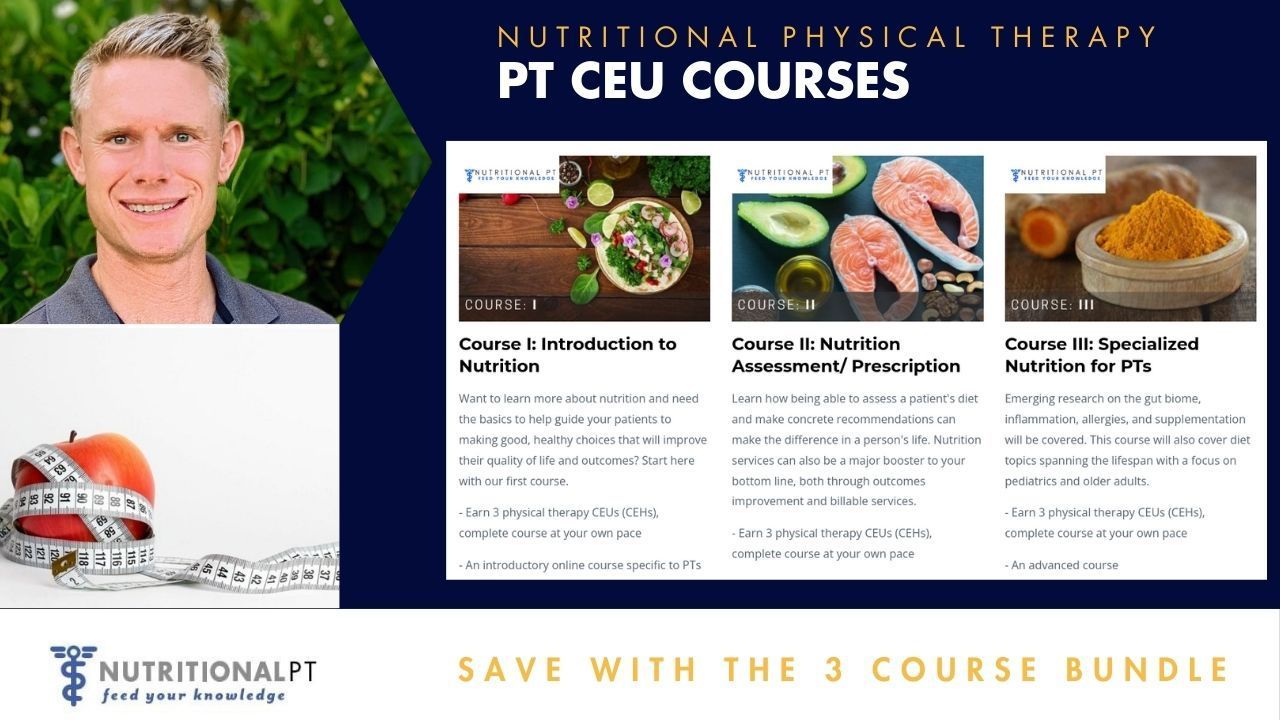Top Physical Therapy CEU Courses for 2026: Featuring Specialized Nutritional Training

Continuing education is vital in the healthcare field, especially for physical therapists who aim to provide the best care for their patients. With evolving techniques and discoveries, staying updated is not just a necessity but also a professional obligation. This article highlights the top Continuing Education Unit (CEU) courses for physical therapists in 2026, including specialized training in Nutritional Physical Therapy, giving you an edge in your practice.
The Importance of CEU Courses
Continuing education plays a pivotal role in the professional journey of a physical therapist. In a rapidly advancing field, staying updated with the latest knowledge and skills is essential not just for personal growth but also for the welfare of patients.
Why Pursue Continuing Education? Continuing education ensures that physical therapists remain informed about the latest advancements in treatment, technology, and patient care. It offers a platform for professionals to refine their existing s...
Alabama PT License Renewal: Your Comprehensive Guide to CEU Requirements

Welcome to your guide for successfully navigating the Alabama PT license renewal process. Understanding these rules is critical for every physical therapist (PT) and physical therapist assistant (PTA) to maintain their active status.
This document explores the specific Alabama PT CEU requirements and identifies viable PT CEU courses to keep your knowledge current.
The Essentials of Alabama PT License Renewal
The Alabama Board of Physical Therapy outlines the mandatory annual requirements for Alabama PT license renewal.
- Annual License Expiration, October 1 of the year following issuance
- Annual Renewal Period July 1 through September 30 at midnight
- Renewal Fee (PT) $130 Renewal Fee (PTA) $93
- Penalty for Lapsed License Practicing without a valid license can include a fine up to $500, imprisonment, or both.
Alabama PT CEU Requirements: CE Hours Needed
All licensees must submit evidence of physical therapy continuing education hours with their renewal application.
- Standard R ...
Virginia PT License Renewal: Your Comprehensive Guide to CEU Requirements

Welcome to your essential guide for successfully navigating the Virginia PT license renewal process. Understanding these rules is critical for every physical therapist (PT) and physical therapist assistant (PTA) to maintain their active status. This document explores the specific Virginia PT CEU Requirements and identifies viable PT CEU Courses to keep your knowledge current.
The Essentials of Virginia PT License Renewal
The Virginia Board of Physical Therapy outlines the mandatory biennial requirements for Virginia PT license renewal.
- Renewal Cycle: Biennial (Every 2 years)
- License Expiration: December 31st of each even-numbered year
- Active Practice Requirement: Minimum of 320 hours of active practice in the preceding four years
- Renewal Fee (PT): $135 (as of current data) Renewal Fee (PTA): $70 (as of current data)
- Jurisprudence Exam: Not required for renewal, but is for initial licensure. No CE hours are specifically mandated for jurisprudence.
Virginia PT CEU Requirement...
Comprehensive Guide to Florida PT License Renewal (24 CEUs)

Ready to renew your license and keep practicing in the Sunshine State? Successfully completing your Florida PT License Renewal requires hitting that crucial Florida Physical Therapy CEU requirements of 24-hour CEUs every two years. We've broken down the official requirements, mandatory courses, and the step-by-step renewal process set by the Florida Board of Physical Therapy. Whether you're a seasoned Physical Therapist (PT) or a Physical Therapist Assistant (PTA), this guide has everything you need to ensure compliance before the deadline.
Florida Physical Therapy Board Information & Renewal Cycle
The Florida Board of Physical Therapy utilizes a biennial (two-year) cycle for license renewal. Getting these key dates and details right is the first step in the Florida PT License Renewal process.
Key PT License Renewal Details:
- License Term: Biennial (Two-Year Period).
- Expiration Date: All licenses expire on November 30 of every odd-numbered year.
- Next Renewal Date: November 30...
Florida Physical Therapy CEU Requirements 2026

In the ever-evolving field of physical therapy, staying updated with the latest knowledge and skills is paramount. This is why continuing education is not just a requirement but a vital component of professional growth and patient care excellence. As we look ahead to 2026, let's delve into the specifics of the Florida Physical Therapy Continuing Education Unit (CEU) requirements, ensuring that physical therapists remain at the forefront of their practice.
Florida, known for its robust healthcare regulations, mandates that licensed physical therapists and physical therapist assistants complete physical therapy continuing education courses to maintain their licenses. This ensures that all practicing professionals are equipped with the latest techniques and knowledge to provide top-notch care.
Florida Physical Therapy CEU Requirements: Overview for Florida PT License Renewal
For the 2026 Florida PT license renewal cycle, Florida's Department of Health has outlined the following CEU re...
Benefits of Continuing Education in Physical Therapy: Integrating Nutritional Strategies for Enhanced Outcomes

Continuing education is not just a requirement for physical therapists; it's a pathway to professional excellence and improved patient care. As healthcare evolves, so do the techniques and methodologies that drive effective treatment. Staying updated with the latest advancements through continuing education units (CEUs) and courses is essential for any physical therapist who aims to deliver the best outcomes.
Physical therapy continuing education courses (CEUs) are crucial for maintaining licensure, expanding knowledge, and enhancing skills. These courses cover a wide range of topics, from advanced orthopedic techniques to innovative rehabilitation strategies. By engaging in PT CEUs, therapists ensure they remain at the forefront of the field, equipped with the tools necessary to address diverse patient needs.
Keeping Up with Advances in the Field
The field of physical therapy is dynamic, with new research and technologies emerging regularly. Continuing education for physical therap...
Physical Therapy Continuing Education: Elevating Practice Through Specialized CEU Courses

In the fast-evolving world of physical therapy, staying updated with the latest advancements is crucial. Whether you are a seasoned therapist or just starting your career, understanding the landscape of physical therapy continuing education and pt ceus can significantly impact your professional growth. This article delves into the multifaceted world of continuing education, exploring its importance, the variety of courses available, including specialized offerings from Nutritional Physical Therapy, and the profound impact these have on patient care.
Why Continuing Education is Essential for Physical Therapists
Continuing education for physical therapists is vital for several reasons. It ensures that therapists remain proficient in the latest techniques, tools, and treatments that can dramatically improve patient outcomes. With the healthcare industry constantly evolving, therapists must adapt to new methodologies, research findings, and technological advancements.
Bridging the Knowl...
Evidenced Based Supplements for Endurance Athletes to Beat the Heat
TLDR:
-
Heat and humidity can really hinder performance, as well as pose a risk for heat-related illness. PTs help athletes with fatigue, cramping, heat exhaustion, and more -- could dietary supplements help?
- New research shows promise with Taurine, menthol, and mouth rinsing. Learn the details in our video blog post and sign up today!
If you like what you see here, check out our board-approved continuing education courses for PTs. We cover topics like:
- Nutrition interventions for chronic diseases (e.g., obesity, diabetes, cardiovascular diseases)
- Advanced nutritional strategies to support physical therapy for patients with metabolic disorders
- Case studies demonstrating successful integration of nutrition into physical therapy care plans
Each physical therapy ceu course emphasizes practical, evidence-based learning, ensuring that participants can immediately apply the skills to their clinical practice. Sign up today and save:
Transcript:
Hey y'all, Dr. Wells h...
Topical Magnesium for Muscle Recovery: Does It Work?
TLDR:
-
We know the oral magnesium can offer benefits for some athletes that suffer from cramps, poor sleep, and other ailments.
- Recently a trend of putting magnesium into creams has been popularized and touted as an effective way to reduce delayed onset muscle soreness and improve recovery.
- In our video we review a recent study in JSCR that outlines how improved recovery is unlikely for athletes when using these creams.
If you like what you see here, check out our board-approved continuing education courses for PTs. We cover topics like:
- Nutrition interventions for chronic diseases (e.g., obesity, diabetes, cardiovascular diseases)
- Advanced nutritional strategies to support physical therapy for patients with metabolic disorders
- Case studies demonstrating successful integration of nutrition into physical therapy care plans
Each physical therapy ceu course emphasizes practical, evidence-based learning, ensuring that participants can immediately apply the skills to the...
30-30-30 Diet: Does It Work? Diet Fads Debunked!
TLDR:
-
A social media trending diet called the 30 30 30 Diet has emerged. As a PT I've been asked about this diet several times -- so what is it and what does the research say?
- The 30 30 30 Diet is considered a fad diet, which touts the notion of eating 30 grams of protein within 30 minutes of waking, followed by 30 minutes of brisk walking. Followers and advocates for this diet claim that it helps with weight loss and health.
- Overall the diet is very generalized: 30 grams of protein may be too much for some individuals and not enough for others; moreover, the 30 minutes of exercise may be dosed too low for some individuals (athletes) and too high for others (frail adults). The precepts of the fad diet overall are not innately harmful: they just might not be specific enough for optimal outcomes.
If you like what you see here, check out our board-approved continuing education courses for PTs. We cover topics like:
- Nutrition interventions for chronic diseases (e.g., obesity,...



